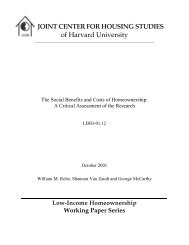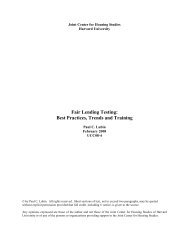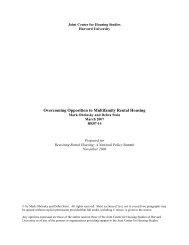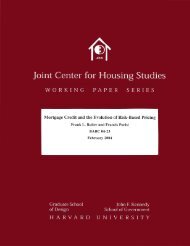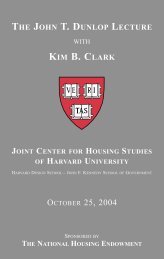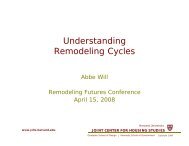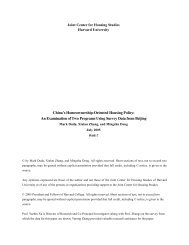please do not cite or circulate without permission of the authors
please do not cite or circulate without permission of the authors
please do not cite or circulate without permission of the authors
Create successful ePaper yourself
Turn your PDF publications into a flip-book with our unique Google optimized e-Paper software.
<strong>the</strong> magnitude <strong>of</strong> <strong>the</strong> impact. While <strong>the</strong> metho<strong>do</strong>logy above allows us to see <strong>the</strong>se preand<br />
post-completion trends, it <strong>do</strong>es <strong>not</strong> provide an easy way to measure <strong>the</strong> degree to<br />
which <strong>the</strong> change in <strong>the</strong> gap after development exceeded what would have occurred,<br />
given pri<strong>or</strong> trends. To arrive at a summary measure <strong>of</strong> impact that controls f<strong>or</strong> <strong>the</strong>se pri<strong>or</strong><br />
trends (that is, a summary measure that controls f<strong>or</strong> how <strong>the</strong> gap between prices in <strong>the</strong><br />
rings and prices in <strong>the</strong>ir community districts has been changing over time), we use a<br />
metho<strong>do</strong>logy similar to Galster, Tatian, and Smith (1999) and estimate <strong>the</strong> following<br />
three equations: 7<br />
(5) LnP = a + bX + cCD*Year + dRing500 + ePostring500 + fspline(T500) +<br />
gTPost500 + є<br />
(6) LnP = a + bX + cCD*Year + dRing1000 + ePostring1000 + fspline(T1000) +<br />
gTPost1000 + є<br />
(7) LnP = a + bX + cCD*Year + dRing2000 + ePostring2000 + fspline(T2000)<br />
+gTPost2000 + є<br />
where X is a vect<strong>or</strong> <strong>of</strong> structural characteristics, such as building age <strong>or</strong> size, and<br />
CD*Year is again a vect<strong>or</strong> <strong>of</strong> year-specific neighb<strong>or</strong>hood dummy variables indicating <strong>the</strong><br />
year <strong>of</strong> sale and <strong>the</strong> community district in which <strong>the</strong> property is located. We <strong>the</strong>n include<br />
a set <strong>of</strong> variables that capture whe<strong>the</strong>r a sale is within a given distance <strong>of</strong> a project site.<br />
The first model, f<strong>or</strong> instance, includes Ring500, a dummy variable indicating if <strong>the</strong><br />
property is located within 500 feet <strong>of</strong> a Nehemiah <strong>or</strong> Partnership site regardless <strong>of</strong><br />
whe<strong>the</strong>r development has been completed. The second model includes Ring1000,<br />
indicating if <strong>the</strong> property is located within 1,000 feet <strong>of</strong> one <strong>of</strong> <strong>the</strong> sites, and <strong>the</strong> third<br />
model includes Ring2000, which indicates if <strong>the</strong> property is located within 2,000 feet <strong>of</strong><br />
one <strong>of</strong> <strong>the</strong> sites.<br />
Each model also includes a variable to measure whe<strong>the</strong>r a sale takes place after a<br />
project is completed. PostRing500 is a dummy variable that equals 1 if <strong>the</strong> property sale<br />
occurs within 500 feet <strong>of</strong> a completed Nehemiah <strong>or</strong> Partnership development. Similarly,<br />
7 The key difference with Galster, Tatian, and Smith (1999) is that we include CD*Year fixed effects that<br />
allow f<strong>or</strong> community district-specific trends in prices. They use tract-fixed effects instead, which use a finer<br />
level <strong>of</strong> geography but assume that neighb<strong>or</strong>hood-fixed effects are constant over time. As mentioned above,<br />
<strong>the</strong> high density <strong>of</strong> New Y<strong>or</strong>k City makes using census tract*year-fixed effects impractical. A<strong>not</strong>her<br />
difference is that we use splines f<strong>or</strong> <strong>the</strong> time trends to capture a non-linear pattern.<br />
9



